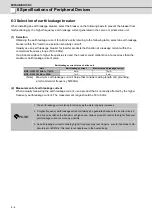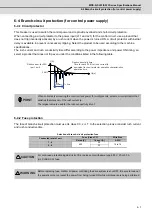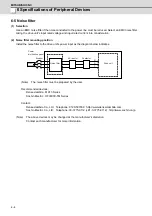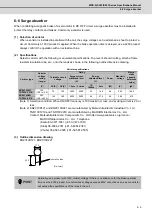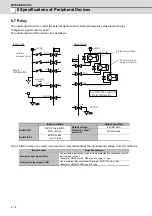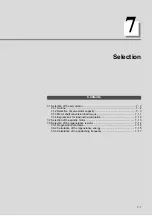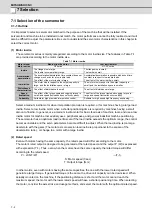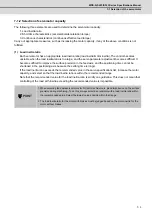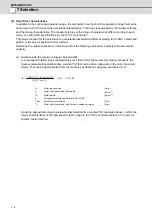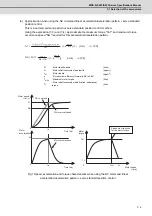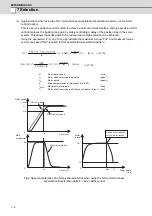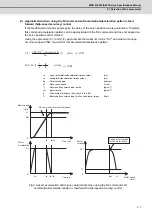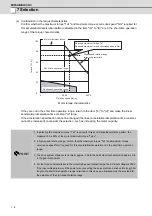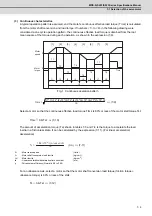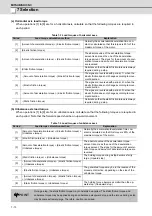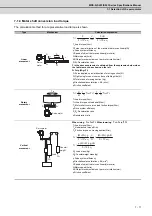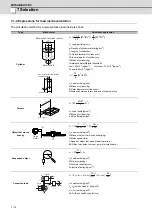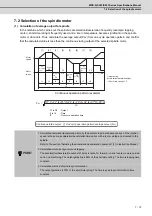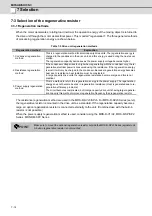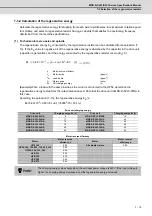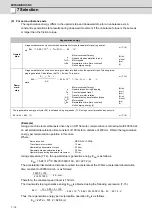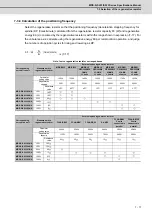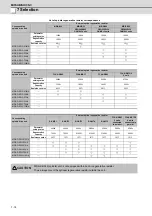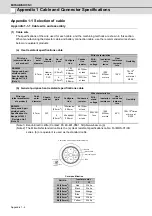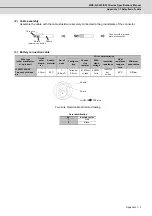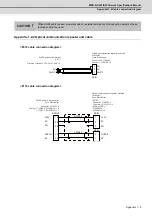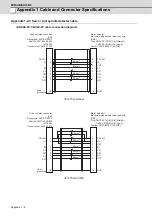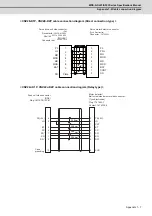
7 - 10
7 Selection
MITSUBISHI CNC
(a) Horizontal axis load torque
When operations [1] to [8] are for a horizontal axis, calculate so that the following torques are required in
each period.
Table 7-3 Load torques of horizontal axes
(b) Unbalance axis load torque
When operations [1] to [8] are for an unbalance axis, calculate so that the following torques are required in
each period. Note that the forward speed shall be an upward movement.
Table 7-4 Load torques of unbalance axes
Period
Load torque calculation method
Explanation
[1]
(Amount of acceleration torque) + (Kinetic friction torque)
Normally the acceleration/deceleration time con-
stant is calculated so that this torque is 80% of the
maximum torque of the motor.
[2]
(Kinetic friction torque)
[3]
(Amount of deceleration torque) + (Kinetic friction torque)
The absolute value of the acceleration torque
amount is same as the one of the deceleration
torque amount. The signs for the amount of accel-
eration torque and amount of deceleration torque
are reversed.
[4]
(Static friction torque)
Calculate so that the static friction torque is always
required during a stop.
[5]
- (Amount of acceleration torque) - (Kinetic friction torque)
The signs are reversed with period <1> when the
kinetic friction does not change according to move-
ment direction.
[6]
- (Kinetic friction torque)
The signs are reversed with period <2> when the
kinetic friction does not change according to move-
ment direction.
[7]
- (Amount of deceleration torque) - (Kinetic friction torque)
The signs are reversed with period <3> when the
kinetic friction does not change according to move-
ment direction.
[8]
- (Static friction torque)
Calculate so that the static friction torque is always
required during a stop.
Period
Load torque calculation method
Explanation
[1]
(Amount of acceleration torque) + (Kinetic friction torque) +
(Unbalance torque)
Normally the acceleration/deceleration time con-
stant is calculated so that this torque is 80% of the
maximum torque of the motor.
[2]
(Kinetic friction torque) + (Unbalance torque)
[3]
(Amount of deceleration torque) + (Kinetic friction torque) +
(Unbalance torque)
The absolute value of the acceleration torque
amount is same as the one of the deceleration
torque amount. The signs for the amount of acceler-
ation torque and amount of deceleration torque are
reversed.
[4]
(Static friction torque) + (Unbalance torque)
The holding torque during a stop becomes fairly
large. (Upward stop)
[5]
- (Amount of acceleration torque) - (Kinetic friction torque)
+ (Unbalance torque)
[6]
- (Kinetic friction torque) + (Unbalance torque)
The generated torque may be in the reverse of the
movement direction, depending on the size of the
unbalance torque.
[7]
- (Amount of deceleration torque) - (Kinetic friction torque)
+ (Unbalance torque)
[8]
- (Static friction torque) + (Unbalance torque)
The holding torque becomes smaller than the up-
ward stop. (Downward stop)
During a stop, the static friction torque may constantly be applied. The static friction torque and
unbalance torque may be applied during an unbalance axis upward stop, and the torque during a stop
may become extremely large. Therefore, caution is advised.
POINT
Summary of Contents for MDS-D-SPJ3
Page 1: ......
Page 3: ......
Page 5: ......
Page 17: ......
Page 19: ......
Page 21: ......
Page 27: ......
Page 31: ......
Page 39: ...1 8 ...
Page 65: ...2 26 ...
Page 93: ...3 28 ...
Page 169: ...5 58 ...
Page 233: ...Appendix 2 10 ...
Page 257: ...Appendix 4 20 ...
Page 280: ......
Page 284: ......

